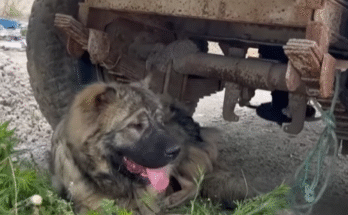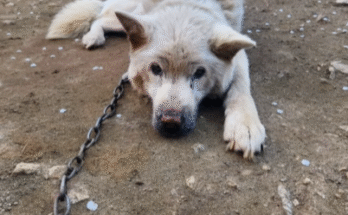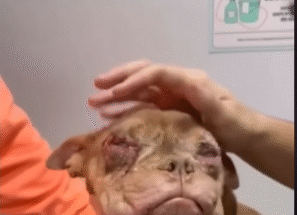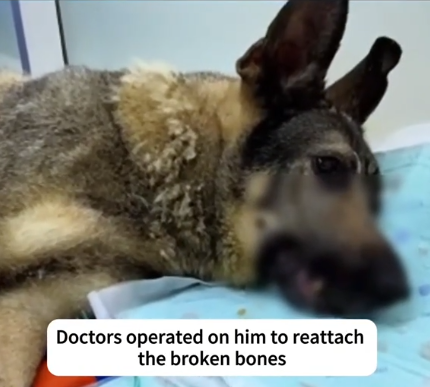
It was an ordinary morning for a cyclist passing through the quiet outskirts of town—a narrow, dusty road flanked by patches of dry grass and scattered trash. But on this day, something unusual caught the cyclist’s eye: a small, motionless figure lying awkwardly in the grass just a few feet from the edge of the road. As he approached, his heart sank. It was a dog. Her legs were tightly bound with rough twine—front and back—completely immobilized, and her eyes, filled with pain and fear, silently pleaded for help.
She had clearly been abandoned, left to die in the heat and filth. The cruelty of the act was staggering. Not only had someone discarded her like garbage, but they had tied her legs together, robbing her of even the basic instinct to flee danger or seek shelter. The twine had cut into her fur and skin, and dried blood crusted around the knots. The dog was dehydrated, weak, and terrified—but still alive.
The cyclist quickly called for help, and within minutes, a local animal rescue group arrived. Gently, they began to cut away the bindings, careful not to cause more pain. The dog flinched with every touch, unsure whether these new humans were friends or more of the same kind who had hurt her. Her breathing was shallow. She hadn’t eaten or drunk water in what seemed like days.
The rescuers named her Hope.
Hope was rushed to a veterinary clinic. She was a medium-sized, mixed-breed dog—brown and white, with soulful eyes and a tail that had once wagged proudly. Now, she couldn’t even lift her head. The vet confirmed she was suffering from extreme dehydration, muscle atrophy, and shock. It was a miracle she had survived as long as she did, tied up and exposed to the elements. But something in Hope was strong—perhaps the faint memory of kindness, or the basic instinct to survive.
Over the next few days, the rescue team poured love and care into Hope’s recovery. They fed her in small, frequent meals and gave her fluids through an IV. Volunteers took turns sitting by her side, gently petting her and speaking in soft voices. They cleaned her wounds and applied ointment to the raw skin on her legs. She trembled at every sound, but slowly, she began to trust.
By the end of the first week, Hope was able to sit up with support. When a volunteer brought her a soft blanket, she rested her head on it and let out a sigh—as if finally, she felt safe. Her tail gave a hesitant wag.
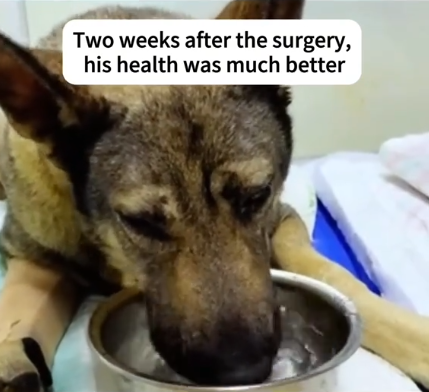
Her story spread quickly online. People were shocked, heartbroken, and angry that any living being could be treated with such disregard. Donations poured in for her medical bills, and messages of love and encouragement flooded the rescue group’s inbox. Hope became a symbol—of resilience, of forgiveness, of the power of second chances.
Week by week, Hope grew stronger. Her appetite returned, her fur began to shine again, and she started learning to walk. Because she had been tied up for so long, her legs were weak and stiff. Physical therapy became part of her daily routine. Volunteers gently exercised her muscles, and eventually, she could stand without support.
Emotionally, she blossomed too. She started greeting her caretakers with soft barks and tail wags. She nuzzled into laps and even gave gentle licks to the hands that fed her. The terrified, broken dog on the roadside had been replaced by a dog rediscovering love and life.
Then came the day everyone had hoped for: Hope was ready for adoption.
Applications came in from all over the country. Families, individuals, dog lovers—all touched by her story—wanted to give her a forever home. But the rescue team was determined to find the perfect match. Hope had been through unimaginable trauma; she needed a home filled with patience, peace, and unconditional love.
After careful screening, they found her match—a retired couple, Anna and Greg, who lived on a quiet farm just outside the city. They had years of experience caring for rescue animals and a home filled with warmth. Most importantly, they understood that healing takes time.
When Hope first stepped into her new home, she was hesitant. The smells were new, the sounds unfamiliar. But Anna knelt beside her, extended her hand, and simply waited. Hope sniffed, paused, and then placed her paw—once tied and bloodied—into Anna’s palm.
From that moment, Hope knew she was home.
She quickly settled into her new life. The farm was a haven for her, with open fields, soft beds, and the loving arms of her new parents. She made friends with the chickens, barked at butterflies, and rolled in the grass without fear. She had found her joy again.
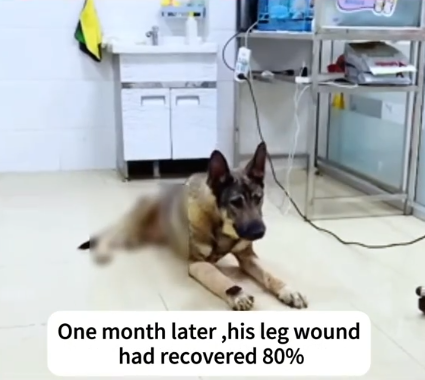
Hope’s story didn’t end with her rescue—it was just the beginning.
Her tale became a catalyst for change in the community. Inspired by her survival, local authorities began investigating animal cruelty cases more seriously. Laws were reviewed, awareness campaigns were launched, and people started speaking out for those who couldn’t speak for themselves. Hope even became the “face” of a local animal welfare campaign, reminding everyone of the suffering that can exist in silence, just feet away from our daily routines.
What happened to Hope was a brutal reminder of the cruelty that still exists. But her survival and transformation were also proof that kindness can triumph, that broken beings can heal, and that even the most hopeless situations can turn around with compassion.
Her story urges us all to stay alert, to act when we see suffering, and to believe in the resilience of animals—and the power of human empathy. It reminds us that rescue isn’t just about saving a life, but also about restoring dignity, joy, and the will to live.
Hope now sleeps curled up at the foot of Anna and Greg’s bed every night. Her legs, once bound, now carry her proudly through wide fields and over grassy hills. Her heart, once broken, now overflows with love.
And her eyes—those same eyes once clouded by fear—now sparkle with the simple, beautiful truth: she is safe, she is loved, and she is home.
